This article was co-authored by Molly DeVoss. Molly DeVoss is a Certified Feline Training and Behavior Specialist (CFTBS), a Certified Cat Behavior Consultant (CCBC), a Fear Free Certified Trainer (FFCT), and the Founder of Cat Behavior Solutions. Molly specializes in using positive reinforcement to modify and prevent unwanted behaviors in cats and reduce cat shelter surrender. Molly has sat on the Dallas Animal Advisory committee since 2013 and was voted one of the Top 12 Extraordinary Cat Behaviorists of 2020 by Catpetclub.com. She is certified by both the Animal Behavior Institute and the International Association of Animal Behavior Consultants. She is also the host of the weekly podcast Cat Talk Radio.
There are 14 references cited in this article, which can be found at the bottom of the page.
This article has been viewed 58,755 times.
Cats can be afraid of many things, from loud noises and thunder to strangers and children. If you think your cat is afraid of something, look at its body language and behavior, as that will typically tell you.[1] Sometimes, fearful cats will also turn aggressive, as they don't know another way to deal with their fear. They may also run away or freeze. Once you notice the signs of fear, try to help your cat deal with it by avoiding triggers and encouraging good behavior.
Steps
Watching Your Cat's Body Language
-
1Look for dilated eyes. When your cat is afraid, its pupils are likely to get large.[2] That means its eye will look mostly black as the pupil fills it. Your cat is trying to see everything it possibly can because it is afraid, and eye dilation helps it do that.[3]
- You've probably noticed the same reaction in humans. When you're watching a horror flick, your eyes "go wide"--dilate--at the scary parts!
- Dilated eyes can also be a sign that your cat is excited, so don't assume this means your cat is afraid. Instead, check the rest of your cat's body language to determine if the cat is afraid or excited. Additionally, it's helpful to consider the current environment.
-
2Check if your cat's ears are flattened. Typically, if your cat is a little afraid, or at least on alert, its ears will be turned to the side. However, if your cat is feeling very threatened or scared, it will flatten its ears out completely, often to the side.[4] [5]
- This posture is different from aggression, where your cat turns its ears back like its ready to attack something.
Advertisement -
3Note whether your cat is wrapping its tail around its body. If your cat is scared, it may try to tuck itself in around its own body.[6] That means it may wrap its tail around itself or tuck it under its body completely.[7]
- This action is likely self-comforting in part.
- Their tail may also be curled forward.[8]
-
4
Watching for Fear to Turn to Aggression
-
1Notice if your cat's hair is bristling. If a cat is upset and afraid, it tries to make itself look bigger by fluffing out. That way, it can scare away whatever it's afraid of. You may notice its hair sticking out on end, for instance, with the whole body puffed up.[13] [14]
- In addition, the cat's tail will likely puff up with the rest of its body.[15] In that case, it may stick straight up or out to make the cat look bigger. It may also swish back and forth.
-
2Watch for an arched back. An arched back is a sure sign your cat is feeling fearful and aggressive. The arch makes them appear bigger to whatever it is its facing in an attempt to scare it off. The arched back and bristling fur usually happen at the same time.[16]
- If you're not sure what an arched back looks like, think of a depiction of a scary Halloween cat with an arched back.
-
3Look for bared teeth and hissing. When your cat is getting aggressive, it may start showing its teeth. That's meant to tell you its feeling threatened and it may attack. When it opens its mouth to show its teeth, it may also make a hissing sound at you.[17] [18]
- Hissing is warning sound that's saying "Back off!"
- Your cat's whiskers will also be held back against their face.[19]
-
4Be ready for swatting, biting, and scratching. When your cat's behavior turns aggressive, you could be hurt in the fray. Your cat may intentionally or unintentionally bite you or scratch you, as a way to show you it can defend itself against whatever is scaring it.[20]
- It may bite or scratch at other animals and things, too, such as a dog or the vacuum cleaner.
Paying Attention to Your Cat's Behavior
-
1Look for loss of bladder and bowel control. If your cat is truly frightened out of its wits, it may defecate or urinate where it is. You may see this happen when you carry your cat in a carrier, for instance, on the way to the veterinarian; your cat may use the bathroom simply because it's frightened.[21]
- Your cat may do this at home, too, particularly if its afraid of another cat, as it may not want to use the same litter box as the other cat.
-
2See if your cat seems frozen in place. While flight or fight are 2 of the normal responses to something your cat is scared of, "freeze" is another response. Think of a deer in the headlights; it's frozen in place because it's afraid. Sometimes, this happens to your cat, too, when it's afraid.[22]
- Your cat may become statue-like, frozen in a scared position.
-
3Notice if it runs away. Your cat is employing the "flight" part of the flight-or-fight response. When faced with a scary situation, your cat's main options are to fight the issue or to run away from it. You may notice it shows other signs of fear and then runs off, for instance.[23]
- If your cat disappears as soon as it hears the vacuum, you can be sure its afraid of it!
-
4Pay attention if your cat hides all the time. A cat who hides away under the bed or in closets is afraid of being out around its humans or of something in your house. That is not necessarily your fault, as some cats are just more fearful than others. Still, you should take note of this behavior so you can try to find ways to deal with it if you can.[24]
- If your cat is new, it may just take time to get used to you.
Helping Your Cat
-
1Leave a hiding cat where it is. If your cat is eating, drinking, and using the bathroom, let it stay in its hiding place for the moment, as long as it is otherwise healthy. Dragging a fearful cat out from its hiding place will only make matters worse. You can still encourage it to come out with a calm voice and treats, but you shouldn't yank it out of its hiding place. [25]
- If possible, place its food, water, and litter box closer to its hiding place. That way, it won't have as far to go to get what it needs.
-
2Ignore an aggressively fearful cat. If the cat turns aggressive on you, your best bet is to act as if the cat isn't being aggressive. That is, the cat wants you to be afraid and retreat, so if you do, it's learned that aggressive behavior gets the result it wants. Instead, hold your ground, but don't try to approach the cat.[26]
- Also, don't try to pet or console the cat, as that could result in you being hurt.
-
3Avoid fear triggers when possible. Of course, you can't avoid everything that makes your cat afraid. Many cats are afraid of the vet, but your cat will likely still need to go. On the other hand, if you know your cat doesn't like children, give it a chance to hide when a child comes over. Avoiding these triggers will help your cat be less fearful.[27]
- Don't intentionally antagonize your cat. For instance, if you find out your cat doesn't like canned air, don't keep spraying the air at it!
-
4Teach your cat to not fear other triggers. With other triggers, try using food to help your cat understand there's nothing to be afraid. For instance, if your cat is afraid of the vacuum cleaner, show your cat the vacuum from across the room and then put it away. If your cat doesn't react aggressively, give it a treat and praise it for good behavior.[28]
- If your cat is aggressive, try repeating the process over time until your cat shows less aggression.
-
5Encourage a shy cat to come out with play. Sit in the room with the shy cat and bring a fishing-type toy.[29] Try to entice the cat out by moving the toy around, getting the cat's attention. It may want to come out and play. If it does, try not to make any sudden movements.[30]
- Over time, the cat will begin to associate the fun time with you and may work up to hanging out with you more.
-
6Introduce strangers slowly to shy cats. If your cat isn't fond of being out and about when friends come over, try working with a single person to help increase your cat's interest. Have the person sit still in a room. Encourage the cat to come into the room with a toy or treats and slowly move it toward the new person. If your cat gets upset, let it go back to the other room, though you can encourage it to come out again with treats or a toy.[31]
- Repeat these sessions, and over time, your cat may become used to having strangers around and even approach one.
-
7Try a pheromone spray or plug-in to help a cat that's always anxious. These products provide similar pheromones to natural ones your cat produces, and it may help soothe an anxiety-ridden cat. You simply spray the air or plug the product into the wall, and it will release pheromones for your cat.[32]
- You can find these online or at most pet stores.
-
8Take your cat to the veterinarian if it suddenly starts acting fearful. Sudden changes in cat behavior can indicate other issues, such as an underlying health issue. If you notice a dramatic change, it's always good to have your cat checked out to make sure nothing else is wrong.
- Make note of any other symptoms you notice, such as a change in eating or bathroom habits.
Expert Q&A
-
QuestionWhat does a scared cat look like?
 Molly DeVossMolly DeVoss is a Certified Feline Training and Behavior Specialist (CFTBS), a Certified Cat Behavior Consultant (CCBC), a Fear Free Certified Trainer (FFCT), and the Founder of Cat Behavior Solutions. Molly specializes in using positive reinforcement to modify and prevent unwanted behaviors in cats and reduce cat shelter surrender. Molly has sat on the Dallas Animal Advisory committee since 2013 and was voted one of the Top 12 Extraordinary Cat Behaviorists of 2020 by Catpetclub.com. She is certified by both the Animal Behavior Institute and the International Association of Animal Behavior Consultants. She is also the host of the weekly podcast Cat Talk Radio.
Molly DeVossMolly DeVoss is a Certified Feline Training and Behavior Specialist (CFTBS), a Certified Cat Behavior Consultant (CCBC), a Fear Free Certified Trainer (FFCT), and the Founder of Cat Behavior Solutions. Molly specializes in using positive reinforcement to modify and prevent unwanted behaviors in cats and reduce cat shelter surrender. Molly has sat on the Dallas Animal Advisory committee since 2013 and was voted one of the Top 12 Extraordinary Cat Behaviorists of 2020 by Catpetclub.com. She is certified by both the Animal Behavior Institute and the International Association of Animal Behavior Consultants. She is also the host of the weekly podcast Cat Talk Radio.
Certified Feline Training and Behavior Specialist & Certified Cat Behavior Consultant Certified Feline Training and Behavior Specialist & Certified Cat Behavior ConsultantExpert AnswerA scared cat may seem motionless and alert, with their body held close to the ground. While standing, their back end may be lower to the ground than the front end. Their legs may also be bent, their breathing may be elevated, and their tail will be curled forward or held close to the body. Typically, the cat's head will be close to the ground with their eyes open and pupils dilated.
Certified Feline Training and Behavior Specialist & Certified Cat Behavior ConsultantExpert AnswerA scared cat may seem motionless and alert, with their body held close to the ground. While standing, their back end may be lower to the ground than the front end. Their legs may also be bent, their breathing may be elevated, and their tail will be curled forward or held close to the body. Typically, the cat's head will be close to the ground with their eyes open and pupils dilated. -
QuestionWhat sounds does a scared cat make?
 Molly DeVossMolly DeVoss is a Certified Feline Training and Behavior Specialist (CFTBS), a Certified Cat Behavior Consultant (CCBC), a Fear Free Certified Trainer (FFCT), and the Founder of Cat Behavior Solutions. Molly specializes in using positive reinforcement to modify and prevent unwanted behaviors in cats and reduce cat shelter surrender. Molly has sat on the Dallas Animal Advisory committee since 2013 and was voted one of the Top 12 Extraordinary Cat Behaviorists of 2020 by Catpetclub.com. She is certified by both the Animal Behavior Institute and the International Association of Animal Behavior Consultants. She is also the host of the weekly podcast Cat Talk Radio.
Molly DeVossMolly DeVoss is a Certified Feline Training and Behavior Specialist (CFTBS), a Certified Cat Behavior Consultant (CCBC), a Fear Free Certified Trainer (FFCT), and the Founder of Cat Behavior Solutions. Molly specializes in using positive reinforcement to modify and prevent unwanted behaviors in cats and reduce cat shelter surrender. Molly has sat on the Dallas Animal Advisory committee since 2013 and was voted one of the Top 12 Extraordinary Cat Behaviorists of 2020 by Catpetclub.com. She is certified by both the Animal Behavior Institute and the International Association of Animal Behavior Consultants. She is also the host of the weekly podcast Cat Talk Radio.
Certified Feline Training and Behavior Specialist & Certified Cat Behavior Consultant Certified Feline Training and Behavior Specialist & Certified Cat Behavior ConsultantExpert AnswerA scared cat may growl, yowl, or hiss at you. At this time, they'll hold their whiskers back, too.
Certified Feline Training and Behavior Specialist & Certified Cat Behavior ConsultantExpert AnswerA scared cat may growl, yowl, or hiss at you. At this time, they'll hold their whiskers back, too.
References
- ↑ Molly DeVoss. Certified Feline Training and Behavior Specialist & Certified Cat Behavior Consultant. Expert Interview. 15 July 2021.
- ↑ Molly DeVoss. Certified Feline Training and Behavior Specialist & Certified Cat Behavior Consultant. Expert Interview. 15 July 2021.
- ↑ https://www.vet.cornell.edu/departments-centers-and-institutes/cornell-feline-health-center/health-information/feline-health-topics/feline-behavior-problems-aggression
- ↑ https://www.vet.cornell.edu/departments-centers-and-institutes/cornell-feline-health-center/health-information/feline-health-topics/feline-behavior-problems-aggression
- ↑ Molly DeVoss. Certified Feline Training and Behavior Specialist & Certified Cat Behavior Consultant. Expert Interview. 15 July 2021.
- ↑ Molly DeVoss. Certified Feline Training and Behavior Specialist & Certified Cat Behavior Consultant. Expert Interview. 15 July 2021.
- ↑ https://www.vet.cornell.edu/departments-centers-and-institutes/cornell-feline-health-center/health-information/feline-health-topics/feline-behavior-problems-aggression
- ↑ Molly DeVoss. Certified Feline Training and Behavior Specialist & Certified Cat Behavior Consultant. Expert Interview. 15 July 2021.
- ↑ https://petsymptoms.com/signs-scared-cat/
- ↑ Molly DeVoss. Certified Feline Training and Behavior Specialist & Certified Cat Behavior Consultant. Expert Interview. 15 July 2021.
- ↑ Molly DeVoss. Certified Feline Training and Behavior Specialist & Certified Cat Behavior Consultant. Expert Interview. 15 July 2021.
- ↑ Molly DeVoss. Certified Feline Training and Behavior Specialist & Certified Cat Behavior Consultant. Expert Interview. 15 July 2021.
- ↑ https://www.animalwised.com/why-is-my-cat-afraid-of-me-2702.html
- ↑ Molly DeVoss. Certified Feline Training and Behavior Specialist & Certified Cat Behavior Consultant. Expert Interview. 15 July 2021.
- ↑ Molly DeVoss. Certified Feline Training and Behavior Specialist & Certified Cat Behavior Consultant. Expert Interview. 15 July 2021.
- ↑ https://www.vet.cornell.edu/departments-centers-and-institutes/cornell-feline-health-center/health-information/feline-health-topics/feline-behavior-problems-aggression
- ↑ https://www.vet.cornell.edu/departments-centers-and-institutes/cornell-feline-health-center/health-information/feline-health-topics/feline-behavior-problems-aggression
- ↑ Molly DeVoss. Certified Feline Training and Behavior Specialist & Certified Cat Behavior Consultant. Expert Interview. 15 July 2021.
- ↑ Molly DeVoss. Certified Feline Training and Behavior Specialist & Certified Cat Behavior Consultant. Expert Interview. 15 July 2021.
- ↑ https://www.humanesociety.org/resources/how-help-frightened-cat
- ↑ https://www.humanesociety.org/resources/how-help-frightened-cat
- ↑ https://www.humanesociety.org/resources/how-help-frightened-cat
- ↑ https://www.humanesociety.org/resources/how-help-frightened-cat
- ↑ https://icatcare.org/advice/problem-behaviour/anxious-cats
- ↑ https://www.humanesociety.org/resources/how-help-frightened-cat
- ↑ https://www.vet.cornell.edu/departments-centers-and-institutes/cornell-feline-health-center/health-information/feline-health-topics/feline-behavior-problems-aggression
- ↑ https://www.vet.cornell.edu/departments-centers-and-institutes/cornell-feline-health-center/health-information/feline-health-topics/feline-behavior-problems-aggression
- ↑ https://www.vet.cornell.edu/departments-centers-and-institutes/cornell-feline-health-center/health-information/feline-health-topics/feline-behavior-problems-aggression
- ↑ Molly DeVoss. Certified Feline Training and Behavior Specialist & Certified Cat Behavior Consultant. Expert Interview. 15 July 2021.
- ↑ https://petsymptoms.com/signs-scared-cat/
- ↑ https://bestfriends.org/resources/cat-scared-strangers-how-calm-anxious-cats
- ↑ https://petsymptoms.com/signs-scared-cat/
About This Article
To know if your cat is afraid of something, watch for dilated eyes, flattened ears, and crouching low to the ground, which are all signs that a cat is frightened. Also, monitor how your cat reacts to a situation to tell if it's afraid. If it runs away and hides or freezes in place, it could be a sign that it's scared. You should also keep an eye out for aggressive behavior, like puffed-up hair, hissing, and swatting, since cats sometimes lash out when they're afraid. For more tips from our Veterinary co-author, like how to help your cat when it's afraid of something, read on!


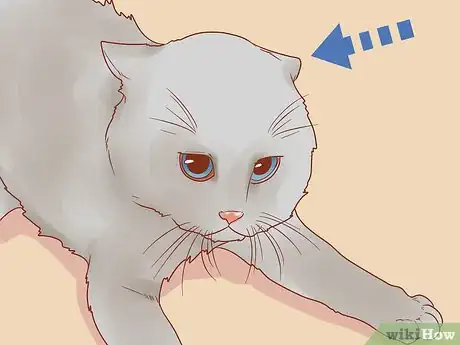
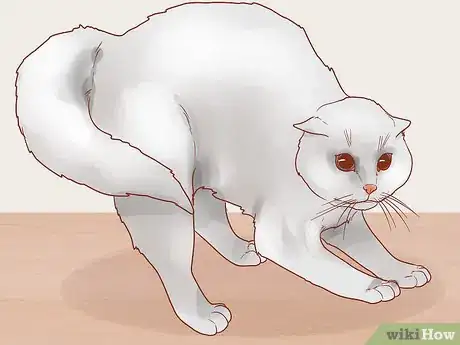
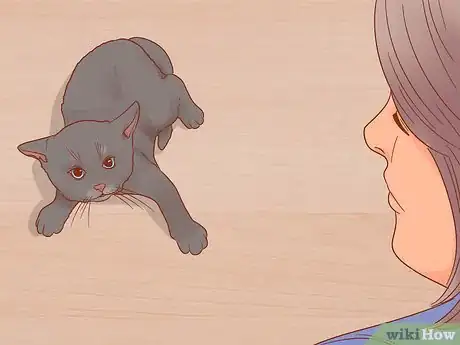
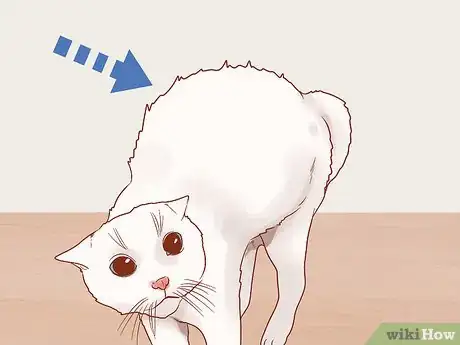

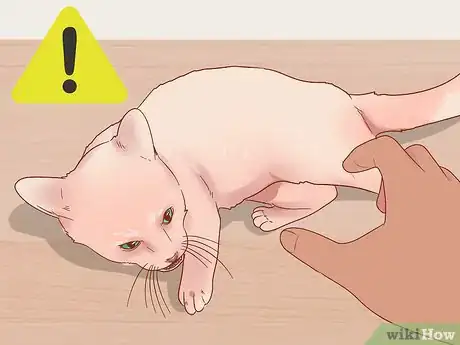
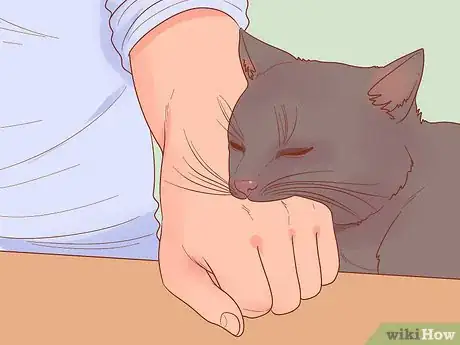
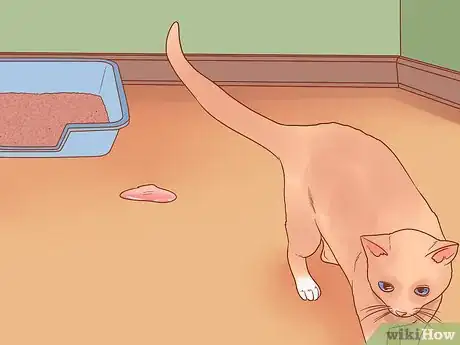

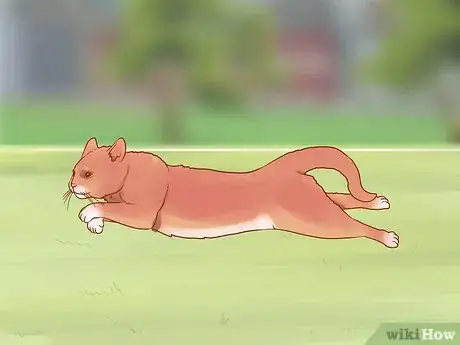
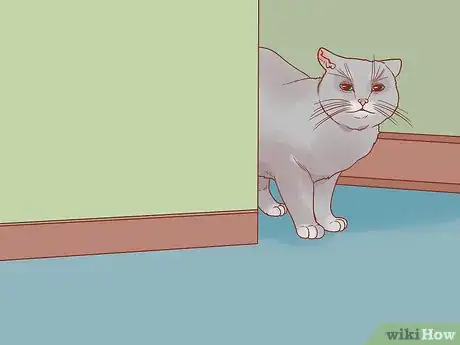
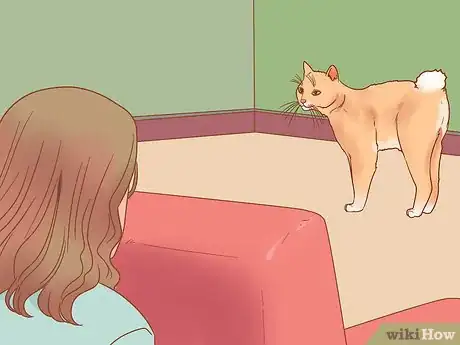

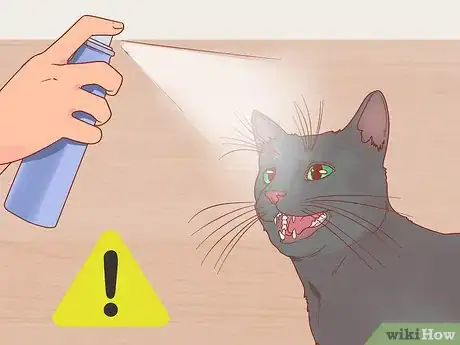

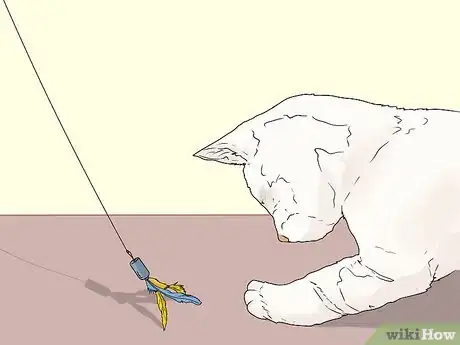
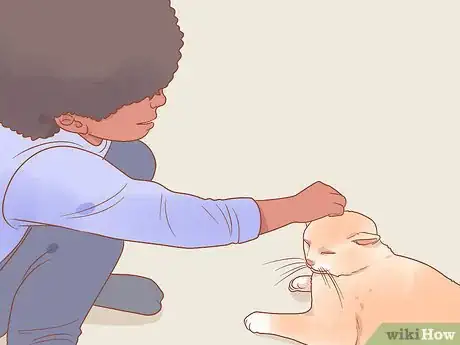
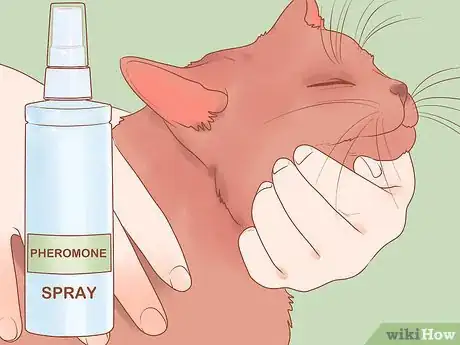
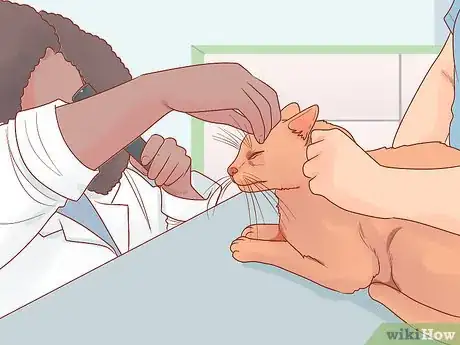
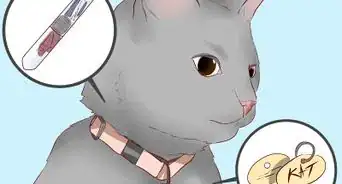



-Step-19.webp)

















































